Today, 23 September 2009, Bruce Springsteen - or The Boss as he's universally known - turns 60 years old.
Once hailed as 'the new Dylan,' New Jersey's Springsteen, usually backed by The E Street Band, has over the course of a nearly 40-year-career become an institution. Of course, he just likes to say that he's merely "a prisoner of rock 'n' roll."
His reputation as a tireless entertainer, known for sweat-filled shows that have run as long as five hours, is the stuff of legend. But for Bruce, there was never any choice in the matter. "If they had told me I was the janitor and would have to mop up and clean the toilets after the show in order to play, I probably would have done it," he once said of his commitment to live performances.
But Bruce Springsteen is more than just the hardest-working man in show business. His songs and lyrics, his dedication to causes for social reform and his unwavering belief that one can talk about a dream and try to make it real (that's from Badlands) have made him one of music's purest and enduring voices.
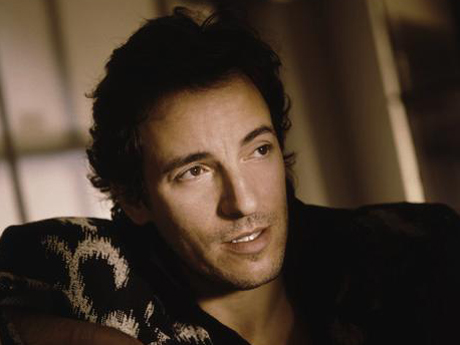
Musical spokesman for a generation, Bruce Springsteen in a reflective moment. IMAGE © Aaron Rapoport/Corbis
In a visual tribute to The Boss on this, his 60th birthday, here is MusicRadar's timeline of the life - via photos and videos, many of which are rare. Happy Birthday, Brooooooce!
Next page: Bruce Springsteen - a life in pictures and videos
September 1949: Bruce Frederick Joseph Springsteen is born in Freehold, New Jersey, USA.
Get the MusicRadar Newsletter
Want all the hottest music and gear news, reviews, deals, features and more, direct to your inbox? Sign up here.
1956: Bruce sees Elvis Presley on TV and is inspired to take up music.
1963: Bruce buys his first guitar at a pawnhop for $18. His mother would later take out a loan to buy him a $60 Kent guitar. "The first day I can remember looking in a mirror and being able to stand what I was seeing was the day I had a guitar in my hand," Bruce said.
1965: Bruce learns 10 songs from the radio and is invited to join a local Freehold band called The Castiles (named after a brand of soap). He quickly develops a rep as a strong guitarist and singer. Marion Vinyard, whose husband sponsored The Castiles, said she always believed Bruce would make it big.
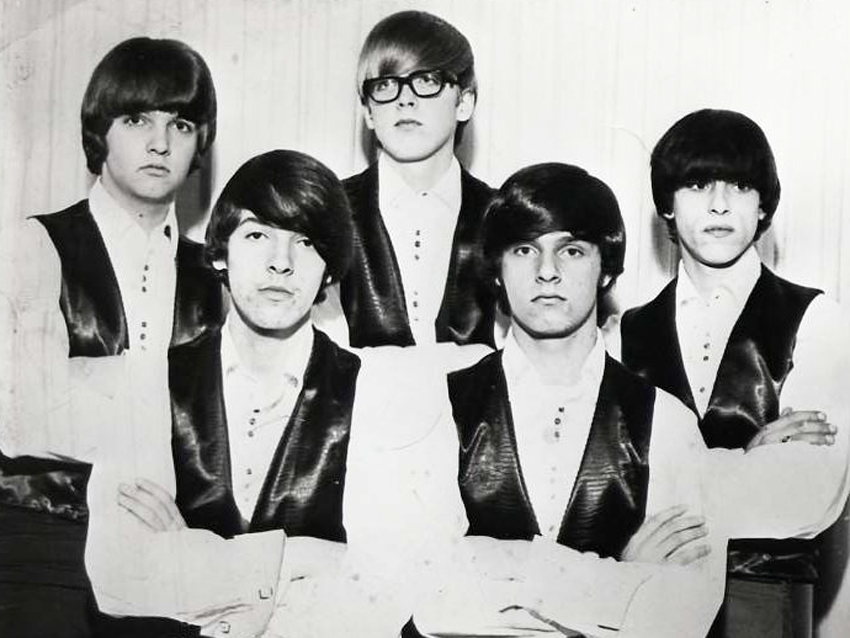
Bruce Springsteen (second from left) as a member of The Castiles.
1969: Having moved to Asbury Park, NJ, Bruce briefly joins the Cream-influenced band Earth. He hooks up with future E Street Band members, drummer Vinnie 'Mad Dog' Lopez and organist Danny Federici and forms a heavy rock/blues-based band called Child. Child soon become known as Steel Mill.
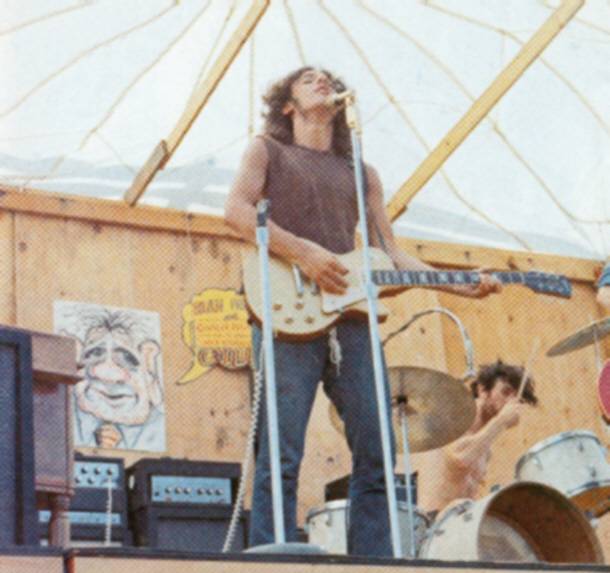
Bruce with a Les Paul(!) in the band Steel Mill.
Next page: Bruce gets a record deal
1971: Springsteen disbands Steel Mill, forms Dr Zoom And The Sonic Boom which morphs into The Bruce Springsteen Band. More future E Streeters come into the fold: pianist David Sancious, bassist Gary Tallent, saxophonist Clarence 'Big Man' Clemons and 'Miami' Steve Van Zandt.
That same year, Bruce meets budding producer Mike Appel. "There was never any doubt in my mind that he was one of the greatest," said Appel. On the hood of a car, Springsteen signs a management contract with Appel - one which would later be called a 'slavery deal.'
1972: Appel arranges a private audition for Springsteen with legendary Columbia Records talent scout John Hammond, who signed Billie Holiday and Bob Dylan. Springsteen plays a folk song It's Hard To Be a Saint In The City. Hammond, convinced he's found 'the new Dylan,' is knocked out and introduces Bruce to Columbia head Clive Davis. A demo is cut and Springsteen is quickly signed to the label.
Video: Rare footage of Springsteen playing Max's Kansas City in New York, 1972.
Next page: "The future of rock 'n' roll..."
1973: Against the wishes of John Hammond, who viewed Springsteen as a folk artist, Bruce releases his debut album Greetings From Asbury Park, New Jersey with the newly named E Street Band. Although it contains songs such as Spirit In The Night and Blinded By The Light (which would hit number one when covered by Manfred Mann), the record is a dismal flop.
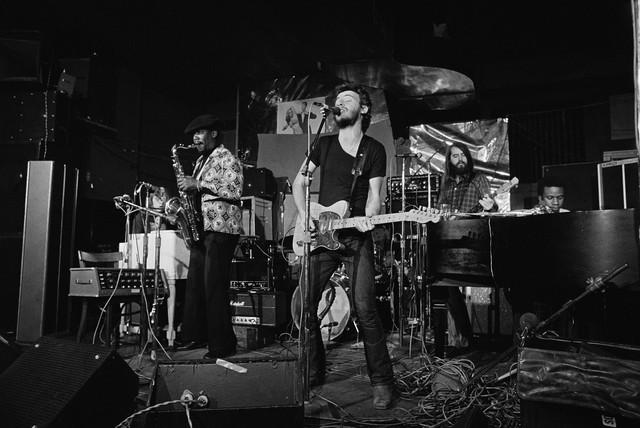
Springsteen performing with The E Street Band in Cambridge, Massachusetts, 1973. IMAGE © Jeff Albertson/CORBIS
1973: That fall, Springsteen releases his second album The Wild, The Innocent & The E Street Shuffle. The record is promoted tirelessly by the Columbia Records staff, is praised by critics - and stiffs. Already there is talk that Bruce might be dropped from the label.
1974: After witnessing a Springsteen show in Cambridge, Massachussetts, influential rock critic Jon Landau writes a rave review for Boston's Real Paper in which he proclaims, "I have seen rock 'n' roll's future and his name is Bruce Springsteen." CBS (Columbia) renews its faith in Bruce and allows him to start work on his third album.
Later that year, Bruce makes two key changes to the E Street Band by hiring pianist Roy Bittan and drummer Max Weinberg.
Next page: Born To Run
1975: After six months of recording, Born To Run, co-produced by Springsteen, Mike Appel and new friend Jon Landau, is released. It is hailed as an instant masterpiece and sales are strong.
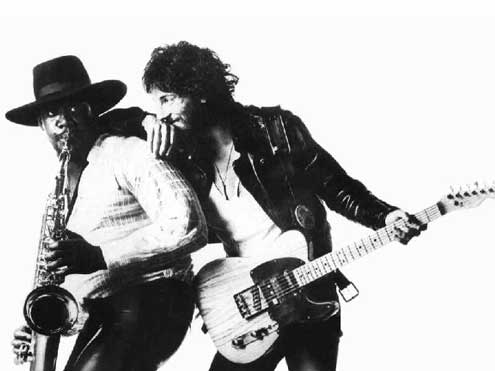
Bruce Springsteen and Clarence Clemmons as they appeared on the cover of Born To Run.
1975: Bruce and The E Street Band play a series of riotously received shows at NYC's Bottom Line. To top things off, Bruce winds up on the covers of both Time and Newsweek - in the same week.
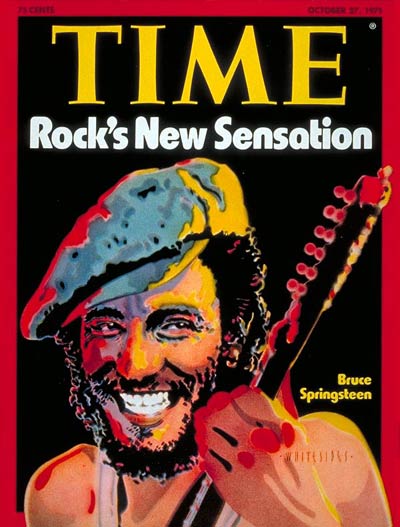
Bruce as he appeared on the 27 October 1975 cover of Time magazine.
1975: Bruce and The E Street Band play London's Hammersmith Odeon. Before the concert, an angry Springsteen rips down CBS promotional posters that read "At Last London Is Ready For Bruce Springsteen," as he feels he's being overly hyped. Nonetheless, he kills in London.
Video: Bruce and The E Street Band play the Hammersmith Odeon in London, 1975
Next page: Legal woes, Darkness
1976-1977: A lengthy and bitter legal situation between Springsteen and Mike Appel keeps Bruce out of the studio to record his follow-up to Born To Run. Bruce discovers that Appel's company owns the publishing to his songs. To make matters worse, Appel files suit to block Springsteen from recording with Jon Landau. The case is eventually settled out of court, and Landau becomes Bruce's manager and defacto producer.
1978: Encouraged by Landau to listen to Hank Williams and watch movies like The Grapes Of Warth, Springsteen writes songs that deal with broken lives and vanished dreams. It all comes together on the album Darkness On The Edge Of Town, which contains songs such as Badlands and The Promised Land. The album is an instant critical and commercial smash, and Bruce embarks on a sold-out theatre and arena tour.
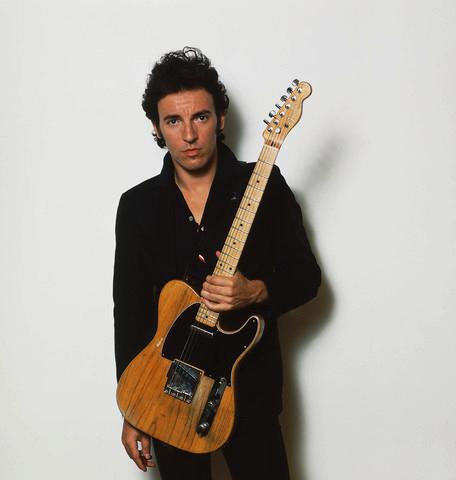
Bruce holding his trusty Fender Esquire, which he has used from 1975 onward. IMAGE © Lynn Goldsmith/Corbis
Video: Bruce is interviewed about his growing popularity, his legal problems and the pressures of success on The Old Grey Whistle Test, 1978.
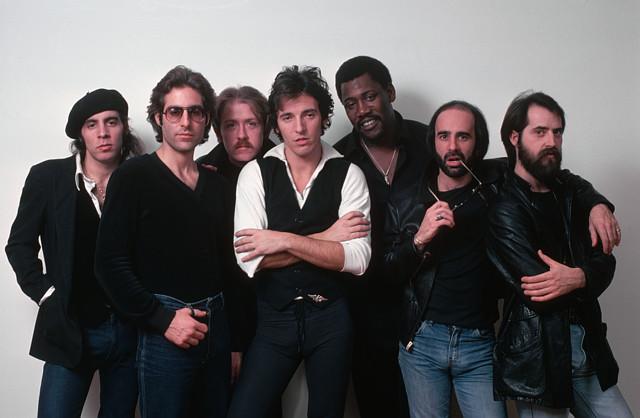
Bruce and The E Street Band, 1978. IMAGE © Lynn Goldsmith/Corbis
Next page: Down to The River
1979: Throughout the year and into the next, Springsteen works on his next record that would include songs such as The Ties That Bind, Hungry Heart, Point Blank and a moving ballad that would become the album's title cut. He previews the song at the No Nukes Concert at Madison Square Garden in September of 1979.
Video: Springsteen and The E Street Band play The River for the first time live, 1979.
1980-1981: On 10 October, 1980, the double-disc The River is released and becomes Bruce's first number one album. Almost immediately, Bruce and The E Street Band begin a tour that will take them around the world several times. Shows are joyous, exhaustive affairs, sometimes lasting four hours (no opening act).
But all isn't fun and games. On 10 December 1980, the night after John Lennon is murdered, the band is set to play a sold-out show at the Spectrum in Philadephia, Pennsylvania. Steven Van Zandt wants to cancel, but Bruce insists they go on. But before tearing into the first song, Springsteen tells the audience, "If it wasn't for John Lennon, a lot of us would be some place much different tonight. It's a hard world that asks you to live with a lot of things that are unlivable. And it's hard to come out here and play tonight, but there's nothing else to do."
Next page: Breaking even bigger
1982: While touring behind The River, Springsteen reads stories by Flannery O'Connor and watches Terence Malick's film Badlands, about the 1958 killing spree committed by Caril Fugate and Charles Starkweather. He records demos for songs, accompanying himself on acoustic guitar, on a four-track tape recorder. Convinced the material won't translate with The E Street Band, he releases the demos - mastered from a cassette! - as the album Nebraska. The song Atlantic City becomes Bruce's first-ever video for MTV.
1983-1984: Bruce and The E Street Band record over 70 songs for a new album. Certain that the record is finished, Springsteen is enraged when John Landau says a key hit single is missing. Bruce storms back to his hotel room and writes Dancing In The Dark. And with that, Born In The USA is complete.
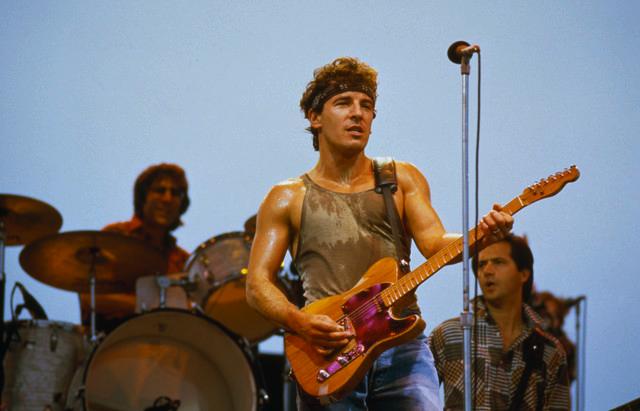
A beefcake-y Bruce in concert with Max Weinberg and Gary Tallent behind him, 1985. IMAGE © Richard Melloul, Gerard Rancinan/Sygma/Corbis
Released on 4 June 1984, Born In The USA becomes a monster hit, eventually selling over 20 million copies. Songs such as Glory Days, My Hometown, I'm On Fire and the title track become radio staples. Having now thoroughly embraced the video-making process, Bruce enjoys nearly round-the-clock play on MTV. But not with this clip - rare rehearsal footage of Springsteen and Clarence Clemmons practicing their dance moves for Dancing In The Dark.
Next page: Big changes for the E Street Band
1984-1985: Before the mammoth Born In The USA tour commences, however, longtime friend and onstage foil Steven Van Zandt decides to embark on a solo career (renaming himself Little Steven). His replacement is former Neil Young guitarist and solo artist Nils Lofgren. In addition, vocalist Patti Scialfa joins the group, changing the dynamic of the formerly all-male E Street Band.
Video: Bruce and The E Street Band play Bobby Jean (written about his friendship with Steven Van Zandt), 1984
1984-1985: Another female enters Bruce's world: model and actress Julianne Phillips. The two meet during Bruce's seven-night stand at the LA Forum in Los Angeles in 1984. They marry on 13 May 1985.
Before this, however, Bruce takes part in the supergroup USA For Africa, lending his vocals to We Are The World, written by Michael Jackson and Lionel Richie. The all-star group of singers and musicians also includes Bob Dylan, Ray Charles, Stevie Wonder, Paul Simon, among many others. The anthem sells over 20 million units worldwide.
Video: USA For Africa - We Are The World, 1985
Next page: Bruce fires the E Street Band
1987-1988: Bruce records his next album differently. Working in his home studio in Rumson, New Jersey, he utilizes synthesizers and drum machines. Members of The E Street Band appear individually on the record, but never as a full group. Tunnel Of Love, is released on 8 October 1987 and includes songs such as Brilliant Disguise, which clues many listeners into the fact that Springsteen's marriage may be in trouble.
In February of 1988, Bruce and The E Street Band embark on a tour for the album, and word spreads of a romance between Springsteen and backup singer Scialfa. The rumors turn out to be true, and by year's end Julianne Phillips files for divorce while Bruce and Patti come out as a couple. During this time, Bruce and the E Street Band take part in the Amnesty International Human Rights Now! Tour, which features Sting, Peter Gabriel, Youssou N'Dour and Tracy Chapman.
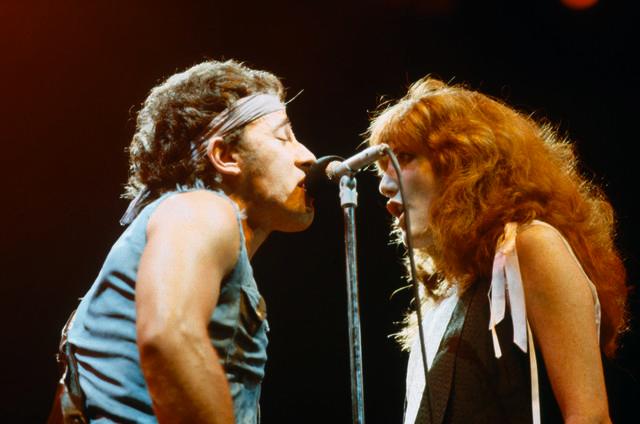
Bruce and Patti Scialfa harmonizing in 1984. Before long, they would become an item and eventually marry. IMAGE © Lynn Goldsmith/Corbis
1989-1991: In October, Bruce shocks the music world by firing The E Street Band, reportedly offering each member $2 million in severance pay. However, in just a few months, Springsteen recruits pianist Roy Bittan to help with the recording of a new batch of songs.
On 25 October 1990, Scialfa gives birth to Evan James Springsteen. The couple marry the following June and move to Beverly Hills, California, concerning many fans. On 30 December 1991, Jessica Rae Springsteen is born.
Next page: Streets Of Philadephia and an Oscar
1992-1993: Recorded mostly with session musicians (although Bittan, Scialfa make appearances, as does one-time E Streeter David Sancious), Human Touch and Lucky Town are two separate albums that Bruce releases on the same day, 31 March 1992. Both albums are panned, as is the ensuing tour, in which Bruce employs Hollywood session players. The only E Street members to appear on the tour are Bittan and Scialfa. The tour does solid business, but it isn't the instant sell-out that his previous outings were. Onstage, Bruce jokes about his poor-selling records, but his humor seems forced.
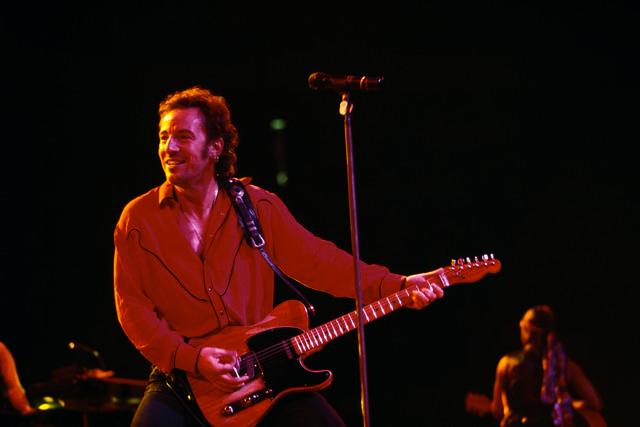
Bruce kicking off his 1992-93 tour at The Meadowlands in New Jersey. IMAGE © Rick Maiman/Sygma/Corbis
1993: Bruce writes and records the song Streets Of Philadelphia for Jonathan Demme's film Philadelphia. The powerful cut - his biggest hit during the '90s - does much to repair Bruce's image to fans who are still angered over his firing of The E Street Band.
1994: Sam Ryan Springsteen is born on 5 January 1994. Meanwhile, Streets Of Philadelphia earns Bruce a Golden Globe Award, an Academy Award and four Grammys.
Video: Bruce performs Streets Of Philadelphia at the 1994 Academy Awards.
Next page: The reunion is on!
1995: While working on a new solo album, Bruce gathers The E Street Band to record two new songs, Blood Brothers and This Hard Land for a greatest hits collection. The band even joins Bruce for a performance on The David Letterman Show and at the opening night of The Rock And Roll Hall of Fame in Cleveland, Ohio. Despite rumors of a full-fledged reunion, Bruce releases The Ghost Of Tom Joad, a haunting, somber solo record. He then embarks on his first-ever acoustic tour of theaters.
Video: Promotional clip on the making of Blood Brothers, 1995.
1998: Bruce releases a 66-song box set of rare outtakes and previously unreleased songs called Tracks, which he dedicates to his father, Douglas Springsteen, who passed away earlier that year. And on 8 December, he announces the reformation of the E Street Band - with a tour to follow.
1999-2000: Bruce is inducted into the Rock And Roll Hall Of Fame, and The E Street Band back him up, the first time the group has been together onstage in four years.
Max Weinberg and Steven Van Zandt are now TV stars (the former as the drummer on the Conan O'Brien Show, the latter in The Sopranos), but both put their TV schedules on hold to take part in a massive world tour. Bruce debuts a few new songs on the road, including American Skin (41 Shots), inspired by the shooting of African immigrant Amadou Diallo by undercover cops. Among the stops the band makes are a 15-night stand at the Continental Airlines Arena in New Jersey (or The Meadowlands, as it's commonly known) and a 10-night run at Madison Square Garden.
Video: Bruce and The E Street Band put on a 'rehearsal' show in Asbury Park, New Jersey, 1999.
Next page: Calling for change
2002-2003: Bruce releases his strongest set of new material in years, The Rising, produced by Brendan O'Brien. The album is mostly a reflection on the aftermath of 9/11 and is a huge critical and commercial success. The ensuing tour is even bigger than Bruce's previous outing with The E Street Band, which includes an unprecedented 10-night engagement at Giants Stadium in New Jersey.
2004: Along with John Mellencamp, John Fogerty, the Dixie Chicks, Pearl Jam, REM, the Dave Matthews Band, among others, Bruce and The E Street Band participate in the Vote For Change tour to encourage people to register to vote. In the final days of the national election, Springsteen makes appearances at campaign stops with Democratic presidential nominee John Kerry. Kerry narrowly loses the election.
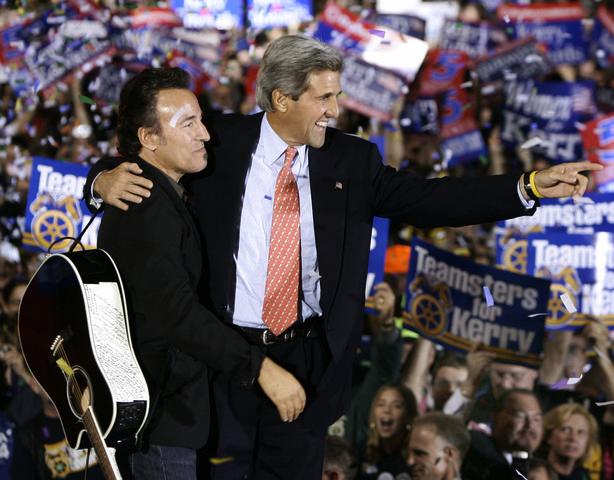
Bruce at a campain stop with Democratic presidential nominee John Kerry, 2004. IMAGE © JIM YOUNG/Reuters/Corbis
2007-2008: After releasing 2005's Devils & Dust, a low-key acoustic set much like Nebraska and The Ghost Of Tom Joad, Bruce issues the album Magic, recorded with The E Street Band and again produced by Brendan O'Brien. Led by the song Radio Nowhere, the album is a strong seller and once again, a sell-out tour follows.
But on 17 April, 2008, tragedy strikes as keyboardist Danny Federici dies following a three-year battle with melanoma.
Also in April, Bruce announces his support of Democratic US Senator Barack Obama for president. Springsteen makes several appearances and plays solo acoustic shows at Obama campaign stops. Obama wins the national election on 4 November.

Bruce with then-presidential hopeful Barack Obama in Cleveland, Ohio, 2008. IMAGE: © Jason Reed/Reuters/Corbis
Next page: The Super Bowl and a big stadium finale
2009: So far, it's been a busy time for Bruce. He releases the album Working On A Dream, cut roughly at the same time as Magic. Along with The E Street Band, he performs during half-time at Super Bowl XLIII. Not a big football fan, Springsteen says of his decision to play: "It was sort of, well, if we don't do it now, what are we waiting for? I want to do it while I'm alive."
Earlier in the year, Springsteen, along with U2, Stevie Wonder, Pete Seeger and many others perform at a pre-inaugural celebration for president-elect Obama that is attended by over 400,000.
After winning a Golden Globe for Best Song, Bruce's track for the 2008 Mickey Rourke starrer The Wrestler, is considered a sure-thing at the Oscars. Surprisingly, the song isn't even nominated.
Video: Bruce Springsteen - The Wrestler, 2008
Currently, Bruce and The E Street Band are winding down a world tour in support of Working On A Dream, which will culminate in a five-night run at Giants Stadium in New Jersey. Those shows will be the last-ever musical events at the venue as it's being taken down to make way for an even bigger facility - once which will undoubtedly host Bruce and The E Street Band before long.
Joe is a freelance journalist who has, over the past few decades, interviewed hundreds of guitarists for Guitar World, Guitar Player, MusicRadar and Classic Rock. He is also a former editor of Guitar World, contributing writer for Guitar Aficionado and VP of A&R for Island Records. He’s an enthusiastic guitarist, but he’s nowhere near the likes of the people he interviews. Surprisingly, his skills are more suited to the drums. If you need a drummer for your Beatles tribute band, look him up.










